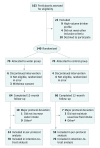Effect of Increased Daily Water Intake in Premenopausal Women With Recurrent Urinary Tract Infections: A Randomized Clinical Trial
- PMID: 30285042
- PMCID: PMC6584323
- DOI: 10.1001/jamainternmed.2018.4204
Effect of Increased Daily Water Intake in Premenopausal Women With Recurrent Urinary Tract Infections: A Randomized Clinical Trial
Abstract
Importance: Increased hydration is often recommended as a preventive measure for women with recurrent cystitis, but supportive data are sparse.
Objective: To assess the efficacy of increased daily water intake on the frequency of recurrent cystitis in premenopausal women.
Design, setting, and participants: Randomized, open-label, controlled, 12-month trial at a clinical research center (years 2013-2016). Among 163 healthy women with recurrent cystitis (≥3 episodes in past year) drinking less than 1.5 L of fluid daily assessed for eligibility, 23 were excluded and 140 assigned to water or control group. Assessments of daily fluid intake, urinary hydration, and cystitis symptoms were performed at baseline, 6- and 12-month visits, and monthly telephone calls.
Interventions: Participants were randomly assigned to drink, in addition to their usual fluid intake, 1.5 L of water daily (water group) or no additional fluids (control group) for 12 months.
Main outcomes and measures: Primary outcome measure was frequency of recurrent cystitis over 12 months. Secondary outcomes were number of antimicrobial regimens used, mean time interval between cystitis episodes, and 24-hour urinary hydration measurements.
Results: The mean (SD) age of the 140 participants was 35.7 (8.4) years, and the mean (SD) number of cystitis episodes in the previous year was 3.3 (0.6). During the 12-month study period, the mean (SD) number of cystitis episodes was 1.7 (95% CI, 1.5-1.8) in the water group compared with 3.2 (95% CI, 3.0-3.4) in the control group, with a difference in means of 1.5 (95% CI, 1.2-1.8; P < .001). Overall, there were 327 cystitis episodes, 111 in the water group and 216 in the control group. The mean number of antimicrobial regimens used to treat cystitis episodes was 1.9 (95% CI, 1.7-2.2) and 3.6 (95% CI, 3.3-4.0), respectively, with a difference in means of 1.7 (95% CI, 1.3-2.1; P < .001). The mean time interval between cystitis episodes was 142.8 (95% CI, 127.4-160.1) and 84.4 (95% CI, 75.4-94.5) days, respectively, with a difference in means of 58.4 (95% CI, 39.4-77.4; P < .001). Between baseline and 12 months, participants in the water group, compared with those in the control group, had increased mean (SD) urine volume (1.4 [0.04] vs 0.1 [0.04] L; P < .001) and voids (2.4 [0.2] vs -0.1 [0.2]; P < .001) and decreased urine osmolality (-402.8 [19.6] vs -24.0 [19.5] mOsm/kg; P < .001).
Conclusions and relevance: Increased water intake is an effective antimicrobial-sparing strategy to prevent recurrent cystitis in premenopausal women at high risk for recurrence who drink low volumes of fluid daily.
Trial registration: ClinicalTrials.gov identifier: NCT02444975.
Conflict of interest statement
Figures


Comment in
-
Drinking More Water for Prevention of Recurrent Cystitis.JAMA Intern Med. 2018 Nov 1;178(11):1515. doi: 10.1001/jamainternmed.2018.4195. JAMA Intern Med. 2018. PMID: 30285051 No abstract available.
-
In premenopausal women with recurrent cystitis, increasing water intake for 12 months reduced recurrence.Ann Intern Med. 2019 Feb 19;170(4):JC16. doi: 10.7326/ACPJ201902190-016. Ann Intern Med. 2019. PMID: 30776805 No abstract available.
-
Can drinking more water prevent urinary tract infections? The evidence says yes.BMJ Evid Based Med. 2019 Oct;24(5):191-192. doi: 10.1136/bmjebm-2018-111143. Epub 2019 Feb 20. BMJ Evid Based Med. 2019. PMID: 30787049 No abstract available.
-
Delivery of Bottled Water to Women With Recurrent Urinary Tract Infections: Why in Bulgaria?JAMA Intern Med. 2019 Mar 1;179(3):448-449. doi: 10.1001/jamainternmed.2018.8240. JAMA Intern Med. 2019. PMID: 30830188 No abstract available.
-
Delivery of Bottled Water to Women With Recurrent Urinary Tract Infections: Why in Bulgaria?-Reply.JAMA Intern Med. 2019 Mar 1;179(3):449. doi: 10.1001/jamainternmed.2018.7977. JAMA Intern Med. 2019. PMID: 30830193 No abstract available.
-
Re: Effect of Increased Daily Water Intake in Premenopausal Women with Recurrent Urinary Tract Infections: A Randomized Clinical Trial.J Urol. 2020 Apr;203(4):644-645. doi: 10.1097/JU.0000000000000719.01. Epub 2020 Jan 7. J Urol. 2020. PMID: 31909656 No abstract available.
-
PURL: Can drinking more water prevent urinary tract infections?J Fam Pract. 2020 Apr;69(3):E19-E20. J Fam Pract. 2020. PMID: 32289134 Free PMC article.
References
Publication types
MeSH terms
Associated data
LinkOut - more resources
Full Text Sources
Medical
Miscellaneous

